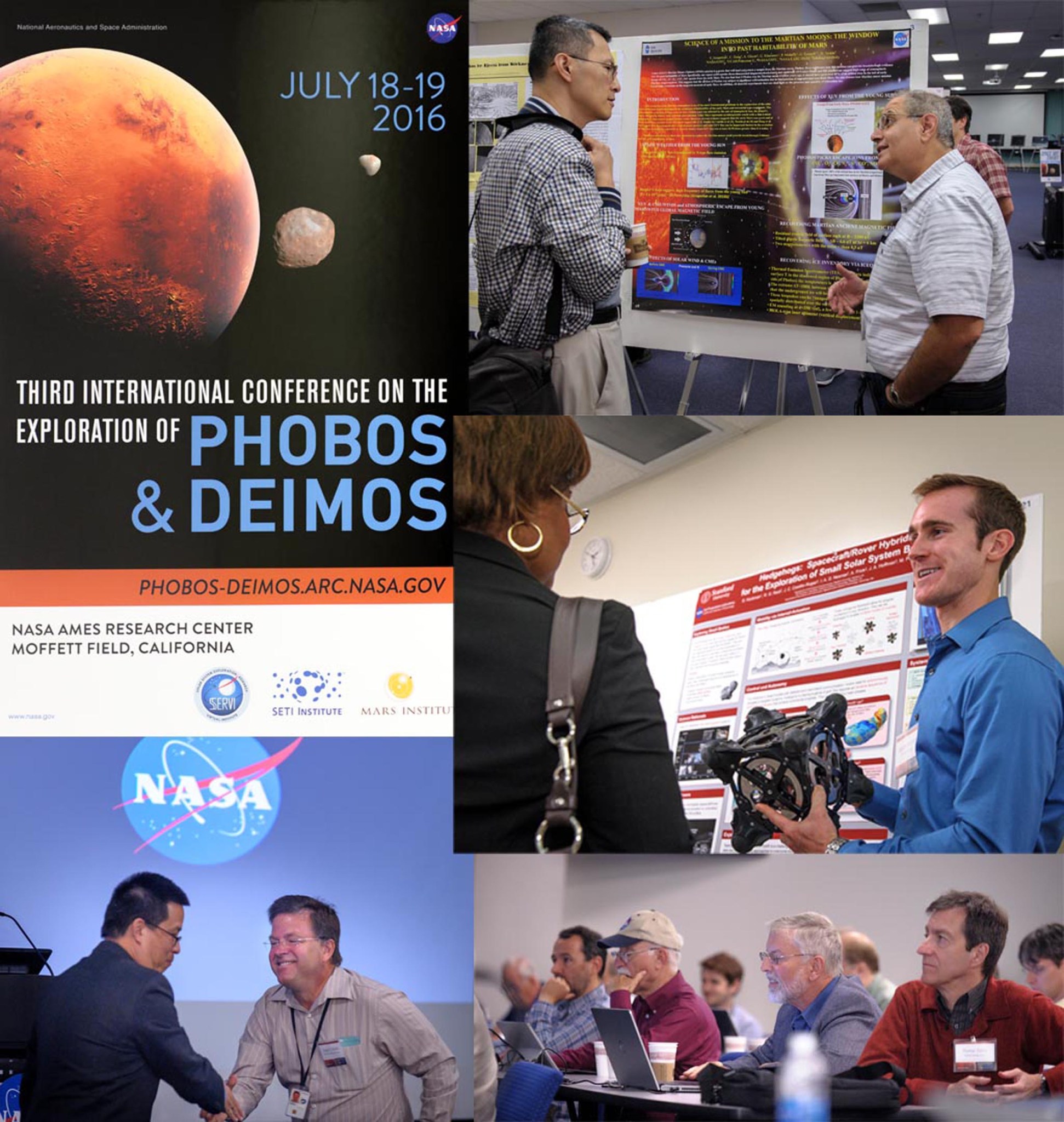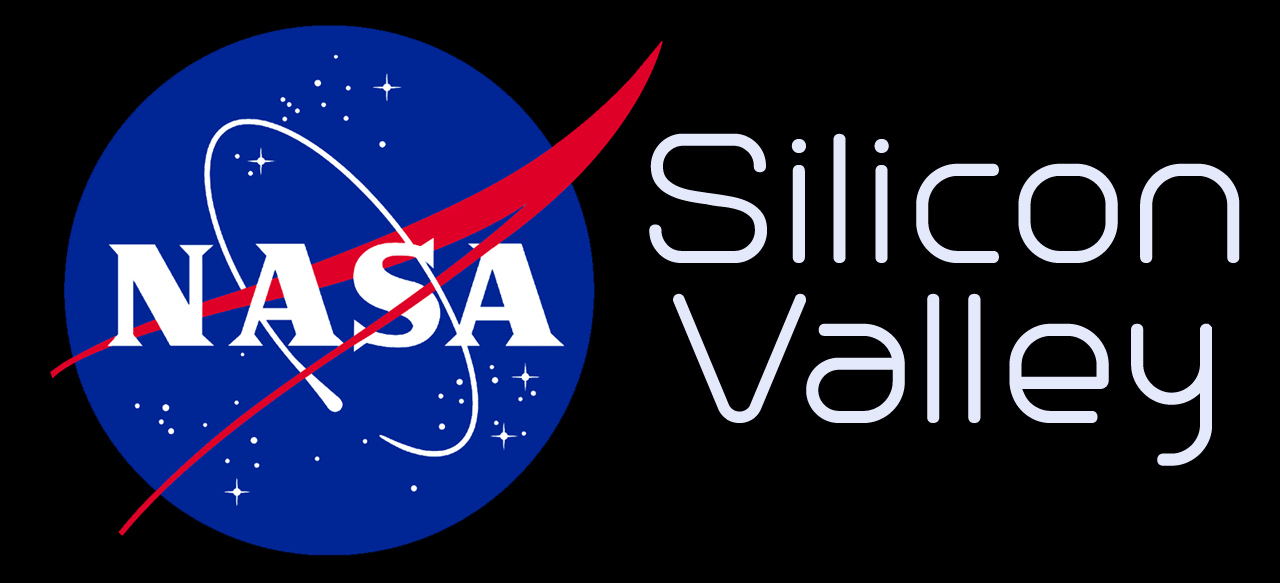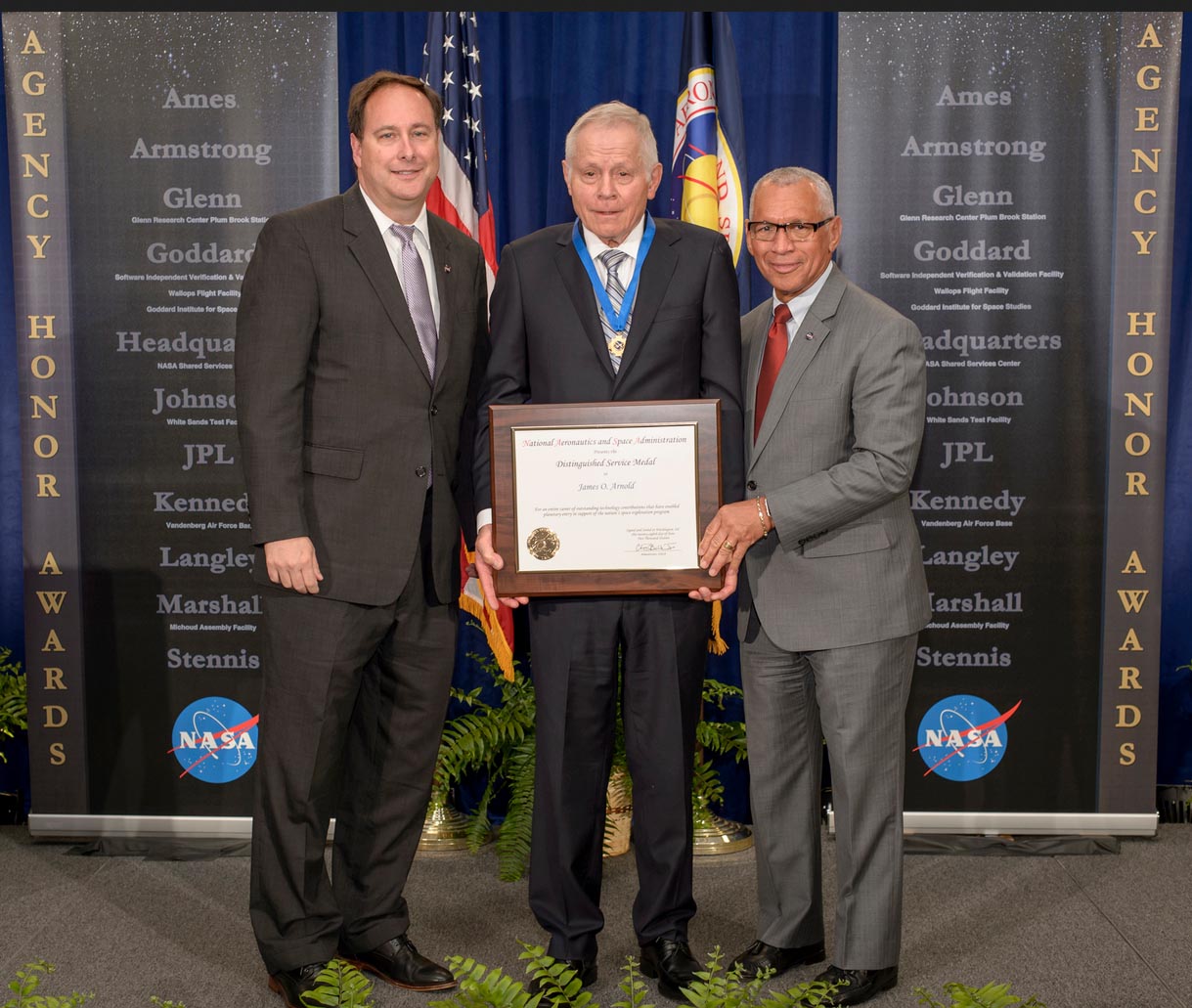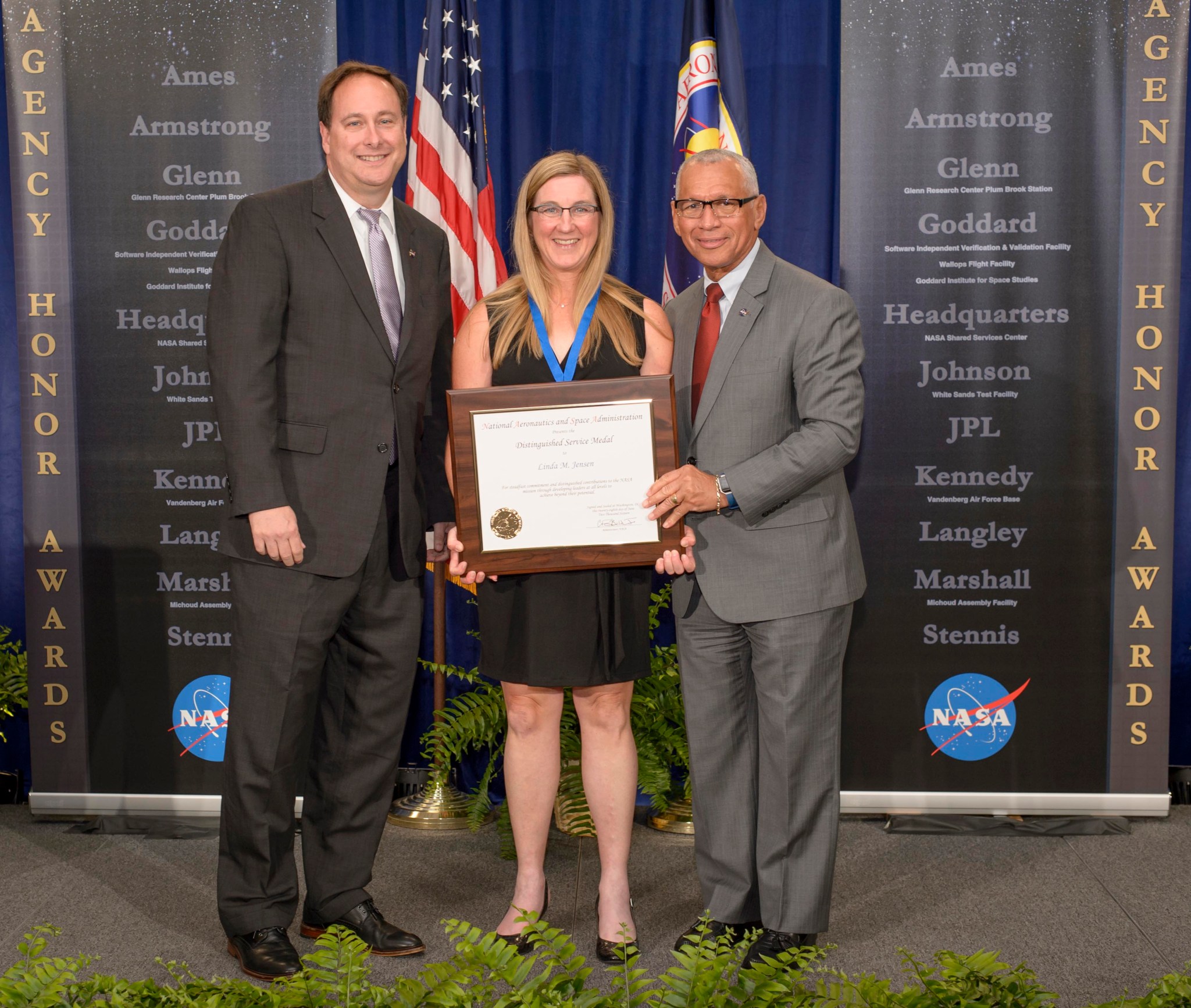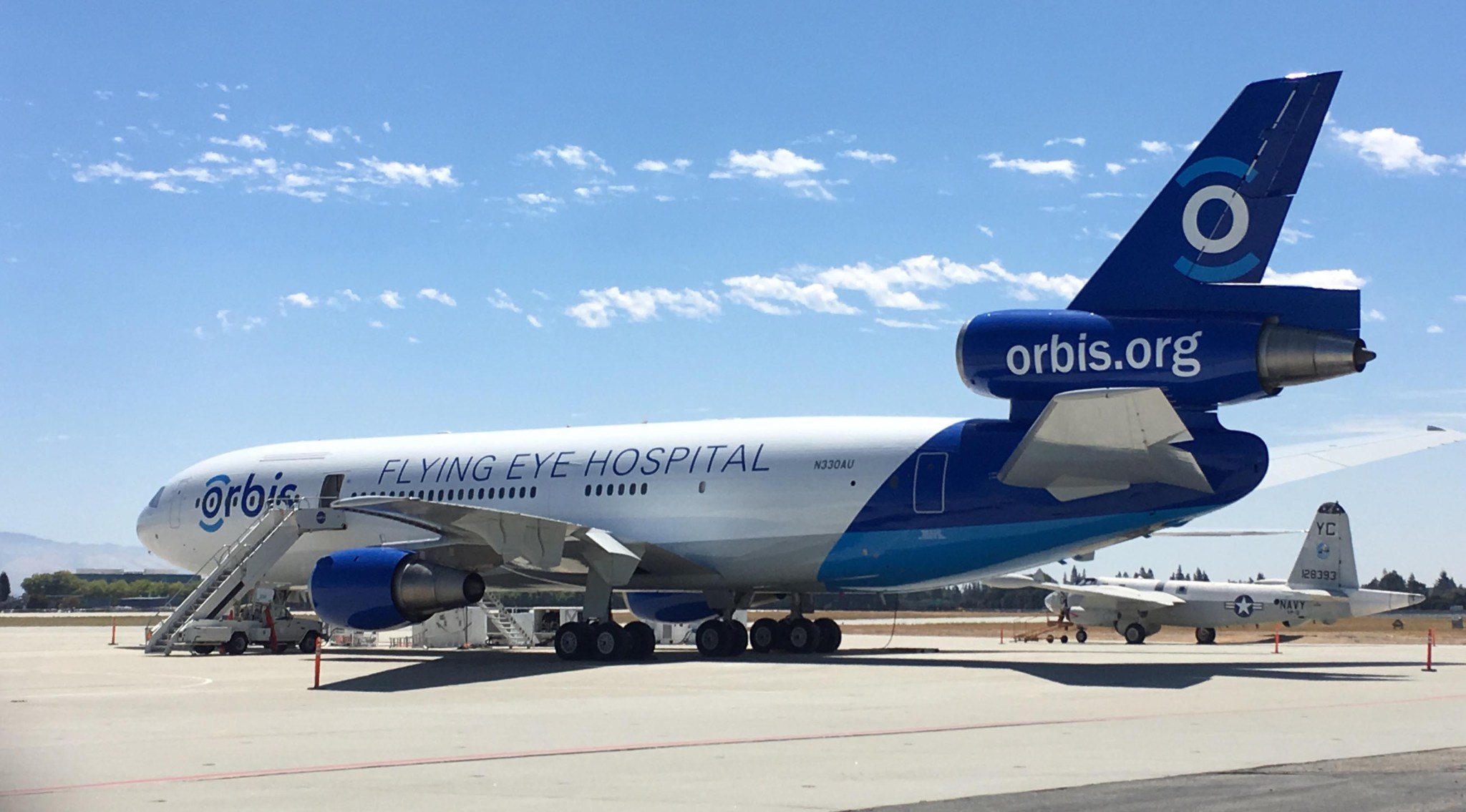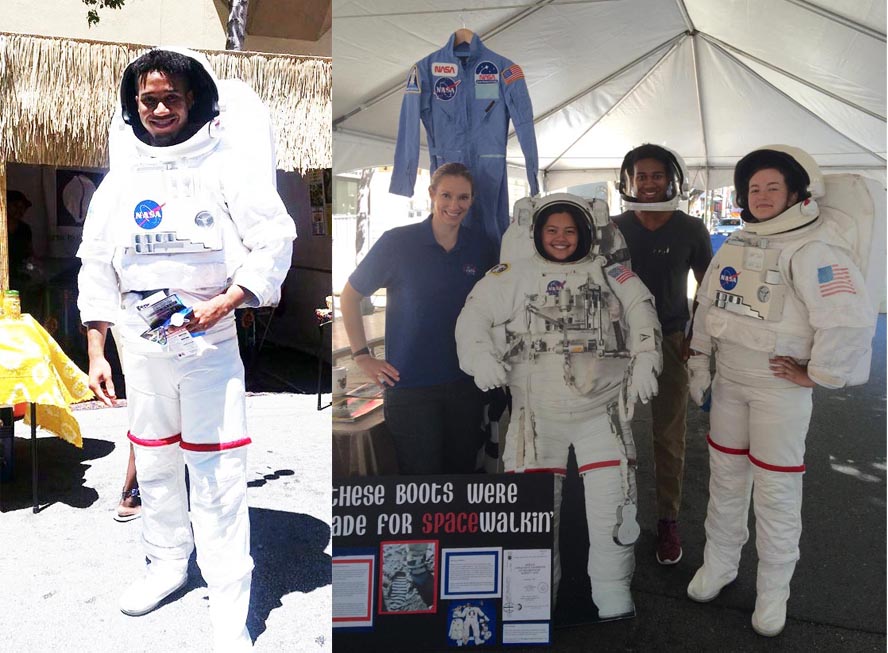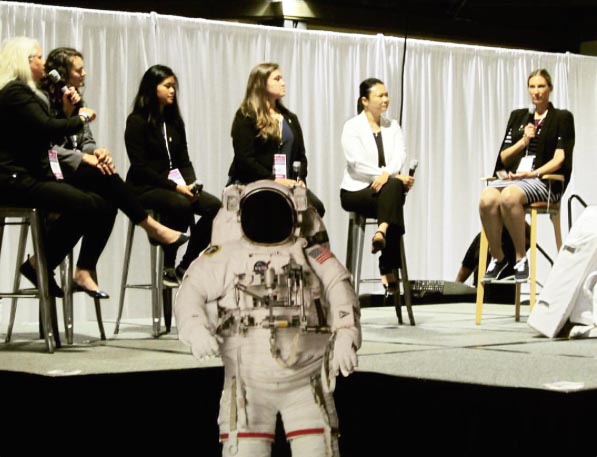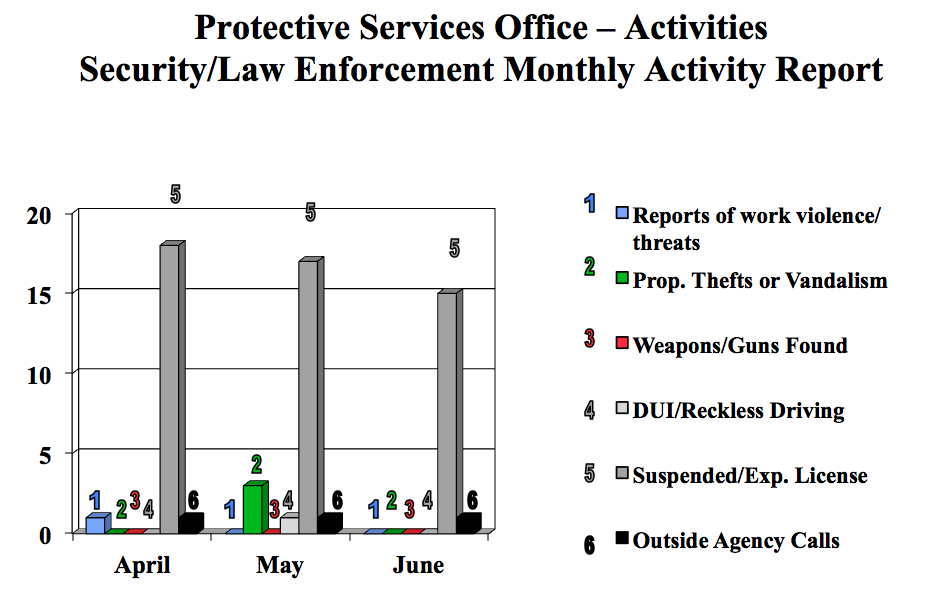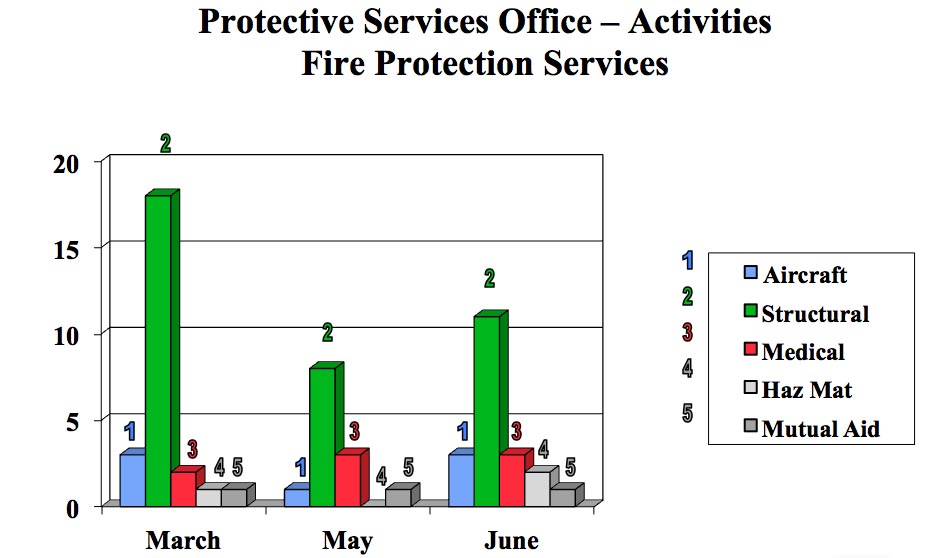Third International Conference on the Exploration of Phobos and Deimos Held at Ames
The Third International Conference on the Exploration of Phobos and Deimos was held at NASA Ames, July 18 – 19, 2016, and focused on those two moons of Mars and how their exploration relates to that of other small bodies. The conference was an open international forum of scientists, engineers, space exploration professionals and students interested in discussing the status and advancement of the exploration of Mars’ two natural satellites, the investigation of other small bodies in relation to Phobos and Deimos, the exploration of Mars itself via its moons, and the importance of exploring these moons for solar system science.
With the growing interest in the exploration of Phobos and Deimos, attendees were presented updates on several international robotic spacecraft missions and concept studies, as well as important new scientific data relating to Phobos obtained recently by NASA’s Mars Atmosphere and Volatile EvolutioN (MAVEN) mission and the European Space Agency’s Mars Express mission.
NASA in Silicon Valley Audio Podcast is Now Available
The new NASA in Silicon Valley podcast series is now available. The conversational audio series is a new platform to talk with the various researchers, scientists, engineers and other interesting people at NASA Ames. Please visit https://www.nasa.gov/ames/NASASiliconValleyPodcast to listen to the podcast or subscribe via iTunes, Google Play or RSS Feed. A new conversation is planned to be made available every Wednesday, in addition to various Ames-related news features throughout the week.
Third Annual NASA Exploration Science Forum Held to Discuss Human Exploration Targets of Interest
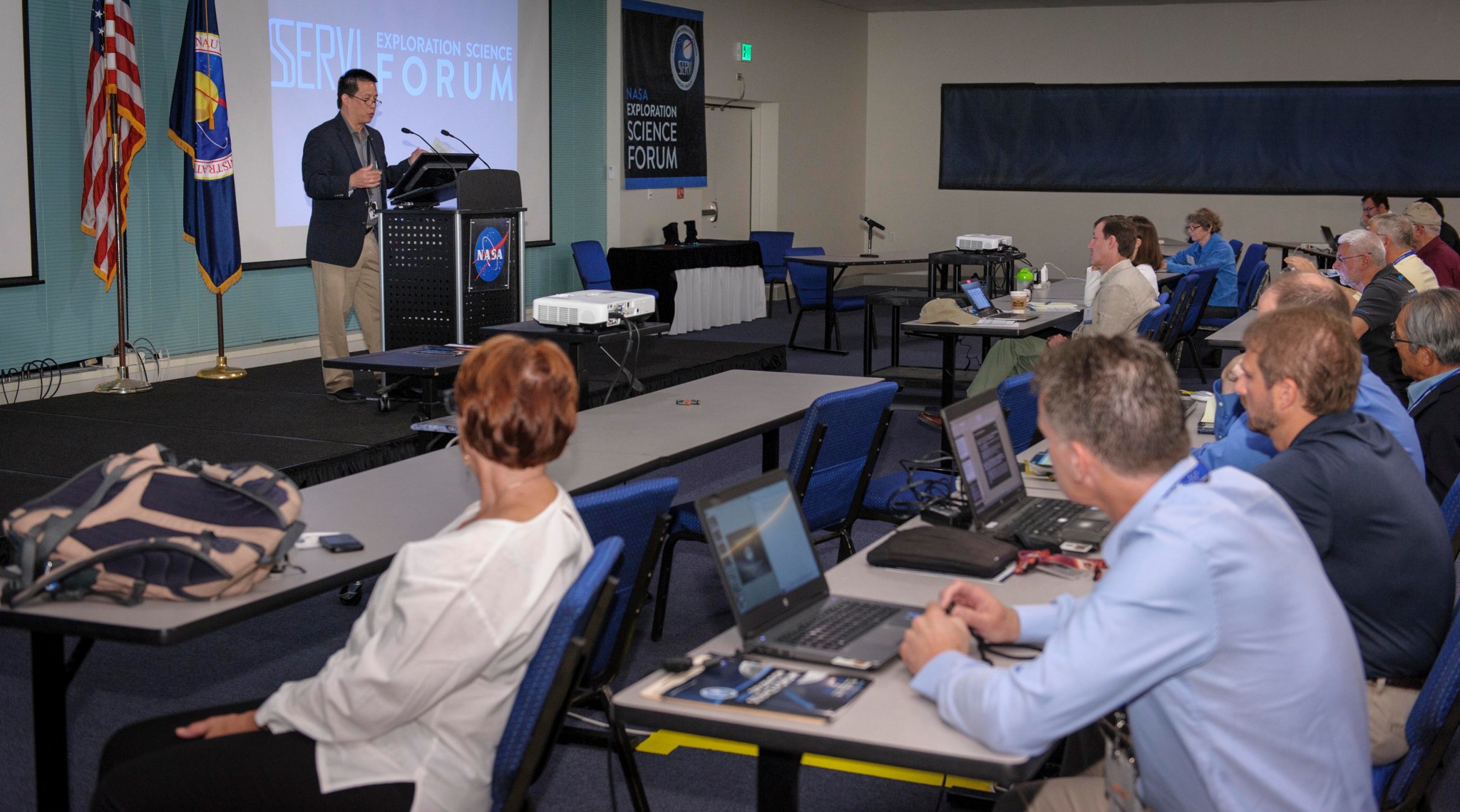
2016 NASA Honor Awards Ceremony Recognizes Exemplary Accomplishments
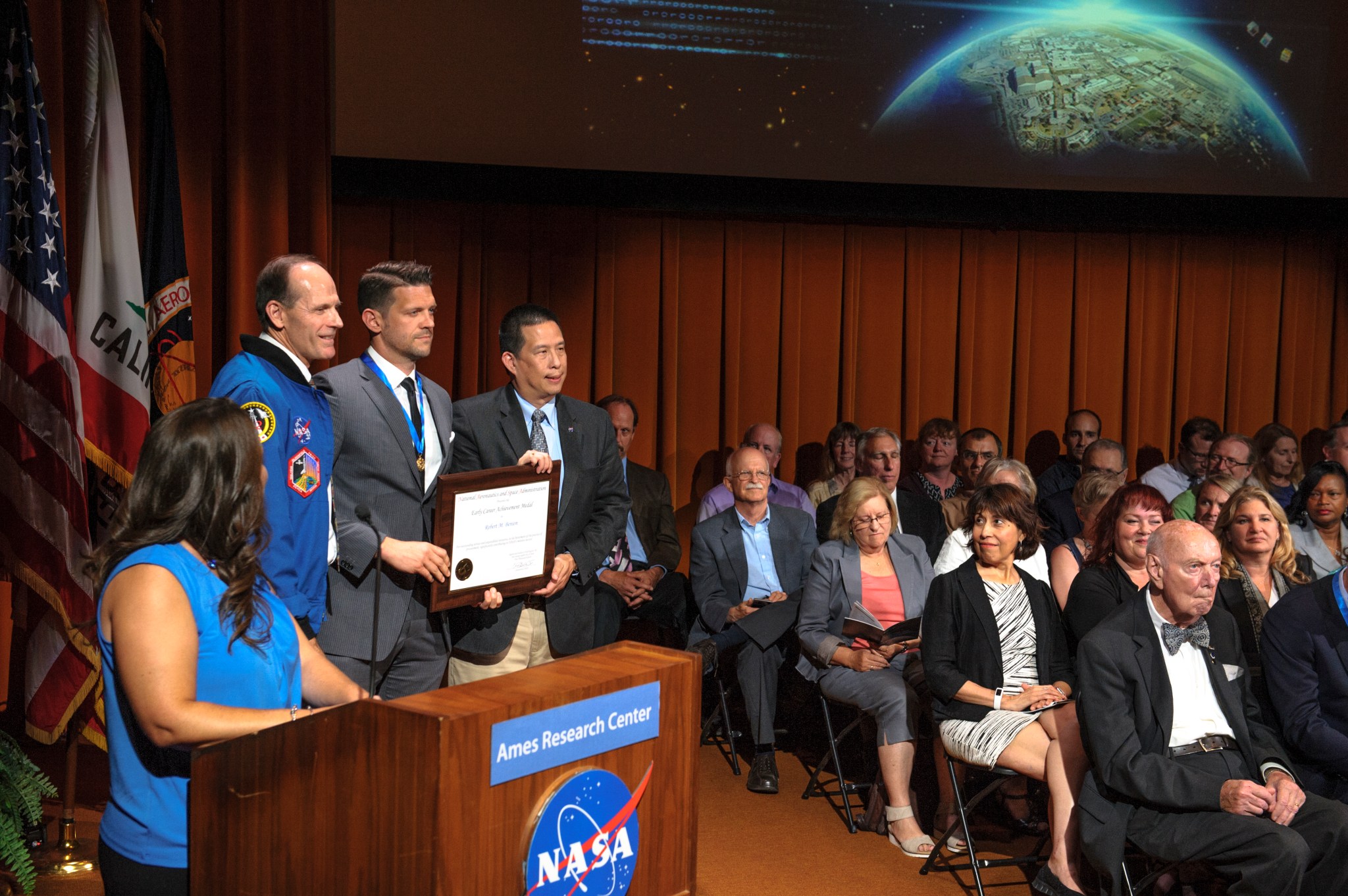
The 2016 NASA Honor Awards Ceremony for NASA Ames was held on July 26, 2016, in the Syvertson Auditorium. NASA Honor Awards were presented to 68 employees who were selected for individual awards, and to 28 groups which have been selected for the NASA Group Achievement Award. The names of the honorees are listed below. Congratulations to all selected.
2016 NASA HONOR AWARDS
Distinguished Service Medal
James O. Arnold
Early Career Achievement Medal
Robert M. Benion, Kenny C. Cheung, Erin E. Flynn-Evans, Scott E. Reardon, Carl R. Russell, David J. Smith, Brandon P. Smith
Early Career Public Achievement Medal
Melanie J. Clarke, Derek J. Dalle, Laura K. Kushner, Sok Chhong Saing
Equal Employment Opportunity Medal
Ved Chirayath, Larry A. Young
Exceptional Achievement Medal
Diana M. Acosta, Carol W. Carroll, William M. Chan, David B. King, Sarah M. Pollock, Confesor Santiago, Kevin E. Witzberger
Exceptional Administrative Achievement Medal
Veronica L. Laird
Exceptional Engineering Achievement Medal
Jeffrey L. Coughlin, John W. Van Norman
Exceptional Public Achievement Medal
Peter P. Berg, James Cunningham, Julianna L. Fishman, Kevin E. McMillin, Suman Muppidi
Exceptional Public Service Medal
Marlene L. Hernan, Robert C. Shaw
Exceptional Scientific Achievement Medal
Christopher J. Burke, Jeffery L. Hollingsworth, Mark S. Marley, Jason F. Rowe
Exceptional Service Medal
Vincent Derilo, Rosalind A. Grymes, J. P. Kamrar, Kevin F. Kouba, Mari E. Matsueda, Gina F. Morello, Robin Orans, Robert M. Padilla, Thomas F. Romer, April E. Ronca Finco, Marianne Shelley, Marilyn Vasques, Gloria K. Yamauchi
Exceptional Technology Achievement Medal
Eduardo A. Bendek Selman, Jay D. Feldman, Parimal H. Kopardekar, Eduardo Solis, Margaret M. Stackpoole, Lee Stone
Outstanding Leadership Medal
Michael S. Craig, Jessica S. Culler, Jessie L. Dotson, Kathleen R. Giffin, Mejghan K. Haider, Edward J. Ingraham, Dave E. Jordan, Susan J. Levine, Julie A. Mikula, Brenda K. Pohl, George L. Sarver, Julie E. Schonfeld, Huy K. Tran, John R. Ulman
Group Achievement Award
3D Multi-functional Ablative TPS
ADEPT Project Ground Testing Team
Advanced Caution and Warning (ACAWS) Team
Airborne Tropical Tropopause Experiment (ATTREX)
AirBOS Testing Team
Airspace Real-Time Safety Modeling Team
Ames SLS CFD Team
Ames Space Portal Team
Arc Jet Operational Recovery Team
ARC SOFIA Financial Management Team
Crew Activity Scheduling System (Playbook) Team
Cube Quest Challenge Team
EDSN Team
EFT-1 Postflight Analysis and Avcoat Extraction
Fallowed Area Mapping Project Team
Hybrid Wing Body Wind Tunnel Testing Team
Mac PIV Authentication Team
NASA Ames Facility Support Services Protest Team
NASA Earth Exchange Team
NSSC’s ARMD Procurement Team
Operational Integration Assessment (OIA) Team
Physics-Based Analysis for Space Launch Sys Design
Quantum Artificial Intelligence Lab (QuAIL) Team
SOFIA Southern Hemisphere Deployment Team
UAV Multicopter Wind Tunnel Test Team
UCSC-ARC HyspIRI Team
UTM Build One Software Team
UTM Convention Planning Team
NASA Ames’ James O. Arnold Wins Distinguished Service Medal
by Ruth Marlaire
The Distinguished Service Award is the highest honor NASA bestows on its workforce. It is awarded to those who display distinguished service, ability or courage, and have personally made a contribution representing substantial progress to the NASA mission. One of this year’s 2016 recipients is James O. Arnold, a scientist and engineer at NASA Ames.
To better share the celebration among NASA employees, the award program is taken on the road to a different NASA center each year. This year the road show was held on June 28 at Ames, when James O. (Jim) Arnold and Linda Jensen were among the 2016 Ames honorees. An incomplete list of Ames honorees include H. Julian Allen (1957), R.T. Jones (1958), Hans Mark (1972, 1977), Charles F. Hall (1974), Leonard Roberts (1976), Lawrence Colin (1980), Charles Hall (1980), Clarence A. Syvertson (1984), John Boyd (1985), Milton O. Thompson (1993), Dale Compton (1994), William Dean (1997), Henry McDonald (2000), G. Scott Hubbard (2004), Bernard Laub (2008), Daniel C. Reda (2012), James Connolly (2013), Wayne Johnson (2013) and Carl Pilcher (2013).
In accepting his award, Arnold reflected on both the people and projects that have been a part of his career.
“I am honored to have been mentored by giants who pioneered the space program; this was of enormous help to me in my career,” said Arnold. “The first was Alvin Seiff. In the early 1960s, Seiff was given the charter to build a group to develop the aerothermodynamics and aerodynamics technology required for the safe lunar return of astronauts aboard the Apollo entry capsule. I was very fortunate to have been hired as a fresh-out and mentored by Seiff.”
Arnold’s personal research and leadership helped revolutionize the technology that probed the planets of Jupiter, Venus and Mars and brought back the first atmospheric data of these planets to Earth.
He has been recognized for the depth and breadth of his technical expertise in areas like aerothermodynamics, high temperature spectroscopy, computational chemistry, nanotechnology and thermal protection systems. In addition, during his management tenure as chief of the Space Technology Division, he ensured the capabilities at the Ames Arc Jet Complex (a thermophysics facility where gases are heated and expanded to very high temperatures and supersonic/hypersonic speeds) and the Ames Ballistic Range Complex (a testing facility where the aerodynamics of entry vehicles are investigated) were fully optimized to contribute to the success of NASA, European Space Agency (ESA) and Japan Aerospace Exploration Agency (JAXA) missions. He also received the prestigious Alvin Seiff Memorial Award in 2013 for his outstanding contributions to the understanding of planetary atmospheres using high-speed entry probes.
“I am delighted that Jim has been honored with NASA’s highest award,” said Thomas Edwards, deputy director of Ames. “Jim’s vision and leadership of hypervelocity flight has enabled NASA’s daring atmospheric entries at Mars and Jupiter, ESA’s Huygens’ mission to Titan, as well as the sample return missions, such as NASA’s Stardust and JAXA’s Hayabusa.”
A 1962 graduate from the University of Kansas at Lawrence, Arnold accepted his first professional engineer position at Ames to work on aerothermodynamics for the Apollo missions. One year later, he collaborated with other Ames scientists on the Planetary Atmospheres Experiments Test (PAET). Seiff theorized that the response of an entry probe could determine the structure and composition of an unknown planetary atmosphere. In 1963, PAET successfully proved this theory by dropping models from a helicopter, airplane and balloon. During the PAET demonstration, Arnold served as the radiometer co-investigator.
“The success of PAET led to every probe mission since then, using this technique in constructing planetary atmosphere of Venus, Mars, Titan and Jupiter; they have led to the practical application of computational chemistry for high-speed flight, and they have defined innovative mission concepts to understand planetary atmospheres,” said Edwards. “He is a role model to many of us, and he represents NASA at its best.”
Arnold’s other key accomplishments include significantly contributing to the understanding of the shock layer physics for vehicles entering the atmospheres of Earth, Mars, Venus and Jupiter; developing a computer code that helped solve entry technology problems; and establishing computational chemistry as a discipline for NASA to study entry physics. Arnold also worked with senior managers at Headquarters and Ames in 1984 to start supercomputing at Ames, which later became the basis for the Numerical Aerodynamic Simulator project, now the NASA Advanced Supercomputing Division at Ames today.
The imprint of Arnold’s management and leadership is with us still today: The Thermophysics Division at Ames, where he served as chief for 17 years, is the agency’s residual capability in the area of hypervelocity atmospheric flight, including thermal protection materials and systems, high enthalpy facilities (arc jets, shock tubes and ballistic ranges) aerothermodynamics and computational chemistry. After 40 years in the civil service, Arnold retired from NASA in 2002.
“As I reflect upon my career, my accomplishments would not have been possible without the help from others who generously shared their expertise and knowledge. A critical element of our future success is our young people. For the next generation to succeed, it is very important for the current generation to mentor them by passing along both their technical and managerial skills,” concluded Arnold.
For more information about the Planetary Atmospheres Experiments Test (PAET), read:
Planetary Entry Probes 1953-2036: a Solar System Exploration, or PAET (Planetary Atmospheric Entry Test) – The Worlds of David Darling
For more information about the Alvin Sieff Award, visit:
http://ippw12.dlr.de/alvin-seiff-memorial-award/
NASA Ames’ Linda Jensen Receives the Distinguished Service Medal
by Ruth Marlaire
The Distinguished Service Medal is the highest honor awarded to a federal government employee who has demonstrated distinguished service, ability or courage, and has personally contributed to substantial progress to the NASA mission. This year, two Ames employees won the award, one of which is Linda Jensen, associate director for Workforce Culture and Employee Engagement, Office of Human Capital at NASA Ames.
Jensen received the award, presented by NASA Administrator Charles Bolden, on Tuesday, June 28, 2016, at an agency award ceremony held at Ames. The other Ames 2016 recipient was James O. Arnold, a scientist and engineer, see above.
“I am so honored to get this award and find it utterly amazing,” said Jensen. “Mostly because I absolutely love the work I do, and I can’t believe I get paid to do it!”
Jensen was recognized for her steadfast commitment and distinguished contributions to the NASA mission by developing leaders at all levels to achieve their potential. For 30 years, she has helped hundreds of employees, from administrative specialists to agency senior leadership, improve their performance and contributions through mentoring, coaching, feedback and sage guidance.
“Linda’s direct role in developing people to be their best has enabled positive career changes, development of individual contributors to leaders, and pushed center leaders to have the confidence to contribute at the agency level,” said Lauren Leo, Office of Human Capital at NASA Headquarters, who nominated Jensen for the award.
Jensen began her career at Ames in 1985 as a co-operative education student intern, hired by Sukie Stanley, to work in Human Resources Development. Over the years, she has served as a trusted advisor to Ames’ senior leaders, while supporting the development of a strong, positive environment to enable the work performed by this center and agency. She performed this function by focusing on developing strong leaders, teams and systems that support the people conducting NASA work. She also supported several agency development programs and organizational development efforts. A major accomplishment was leading the NASA community to move coaching from a remedial activity to an essential part of executive development. To do this, she created an agency supervisory development program, called Leveraging Agency Supervisory Excellence and Resilience (LASER). Under her guidance and leadership, supervision was established as a discipline. Her contribution helped NASA become a national leader in coaching.
Still in disbelief about receiving the agency’s highest honor, Jensen reflected on her many years of service as an Ames employee. “I’ve been lucky to be involved in the creation of several agency programs over the years. That is really fun work!”
The video of the awards ceremony can be viewed here:
Evergreen Middle School Students Present HiRISE Mars Research at Ames
by Natalie Glines and Ginny Gulick
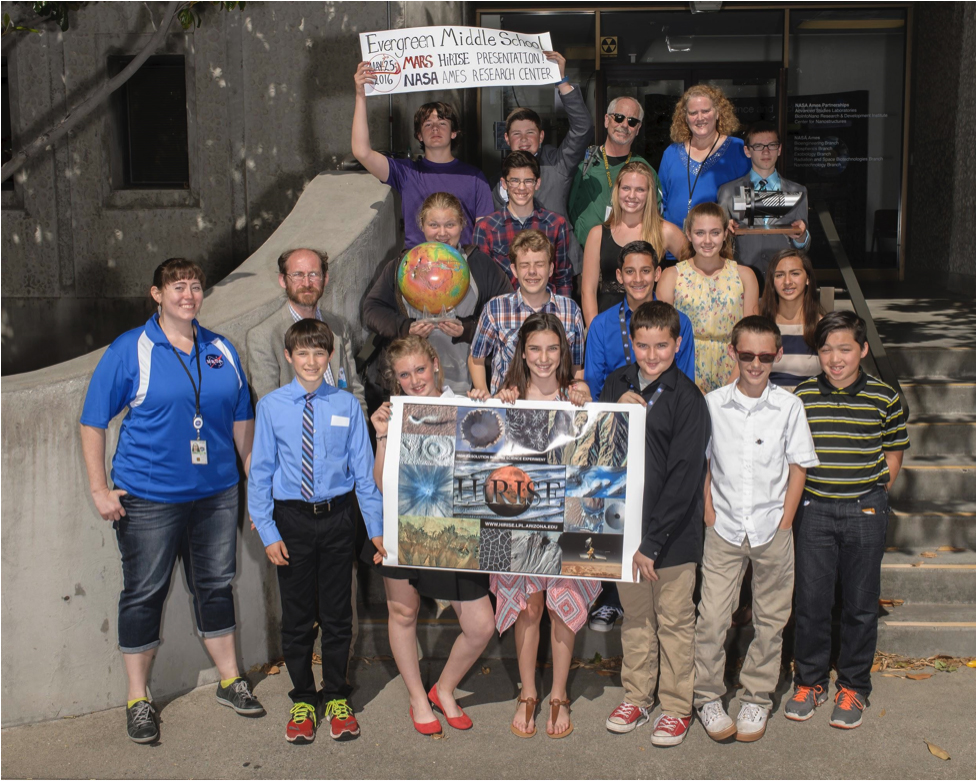
On May 25, 2016, a group of 16 seventh- and eighth-grade students from Evergreen Middle School in Cottonwood, California, visited NASA Ames to present the results of their year-long Mars research projects. The student presentations described their investigations of esker-like inverted terrain, and a mysterious depression in the Tempe Terra region of Mars.
During their visit to Ames, the students also toured the National Full-Scale Aerodynamics Complex (NFAC), the 80-foot-by-120-foot wind tunnel, courtesy of Aeromechanics Branch Chief Bill Warmbrodt and shared an inspirational talk and Q&A session with astronaut Steve Smith.
Over the past eight years, Evergreen teacher Dennis Mitchell has collaborated with SETI Institute senior research scientist at NASA Ames Virginia Gulick, to introduce the middle school students to the science of the planet Mars, through the Mars Student Imaging Project (MSIP) and Gulick’s Mars Reconnaissance Orbiter, High Resolution Imaging Science Experiment (HiRISE) instrument public outreach work. Just like the HiRISE team members, the Evergreen students requested HiRISE images of Mars using HiWeb, the team’s image suggestion tool, analyzed the returned images and wrote captions for the images, which are posted on the HiRISE website.
“The experience for our very rural students is beyond words! We have very limited resources in the Redding area and getting to travel to NASA Ames, see scientists at work and present their research to a panel of scientists helps them grow in so many ways! By the end of their experience they become pretty knowledgeable about Mars and their research topic. Gulick and her team are amazing. The HiRISE Images the students suggest are the coolest! And besides, what kid isn’t fascinated by NASA!” stated teacher Dennis Mitchell.
Eighth grade student Jaidee M. added, “I feel like a scientist! I have always loved space science and now I know I can go college and become an astronomer! My two years on the Evergreen NASA Team has helped me gain the confidence to follow my dreams. And I got to meet a REAL ASTRONAUT and eat lunch with real scientists!”
Office of the Chief Scientist Continues to Present Its Summer Series Colloquiums
Each summer, the Office of the Chief Scientist produces a lecture platform with leaders whose high achievements generate innovative discussion, as well as inspire and catalyze scientific progress. This year, the Summer Series consists of seminars by lecturers from NASA Ames, external NASA staff, as well as renowned colleagues who have and will lecture on topics that span across multiple advanced subject areas including space technology and space exploration.
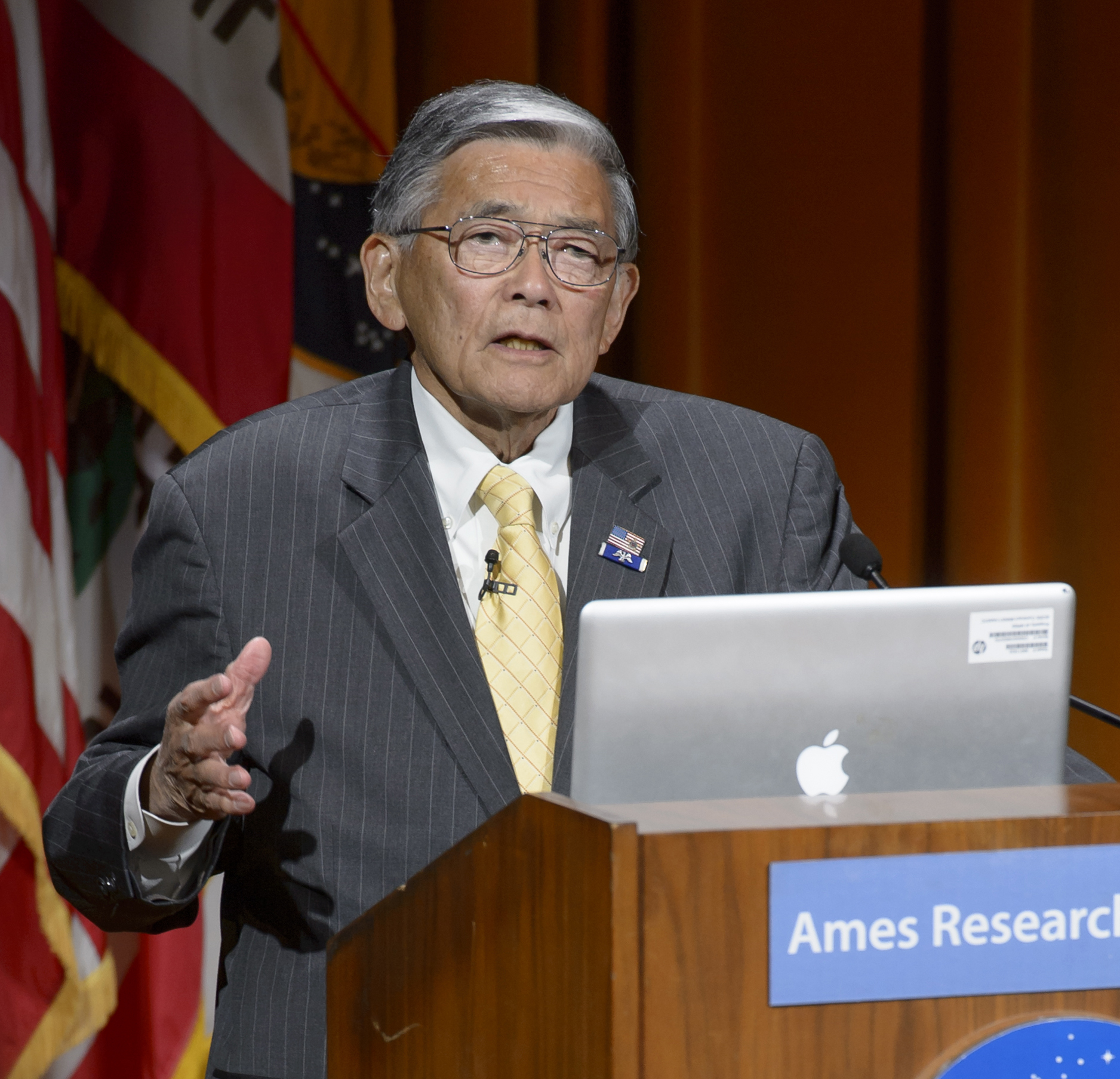
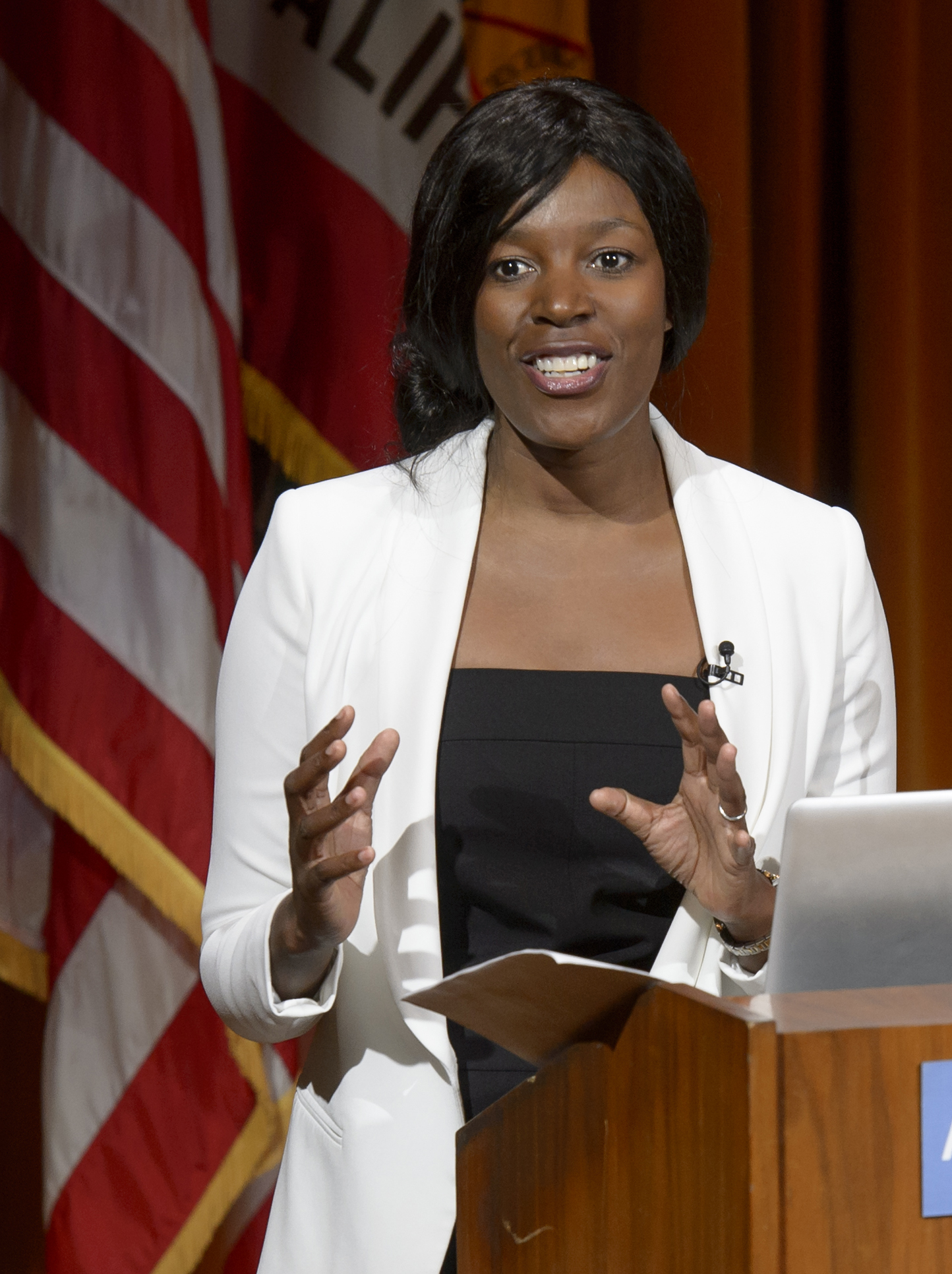
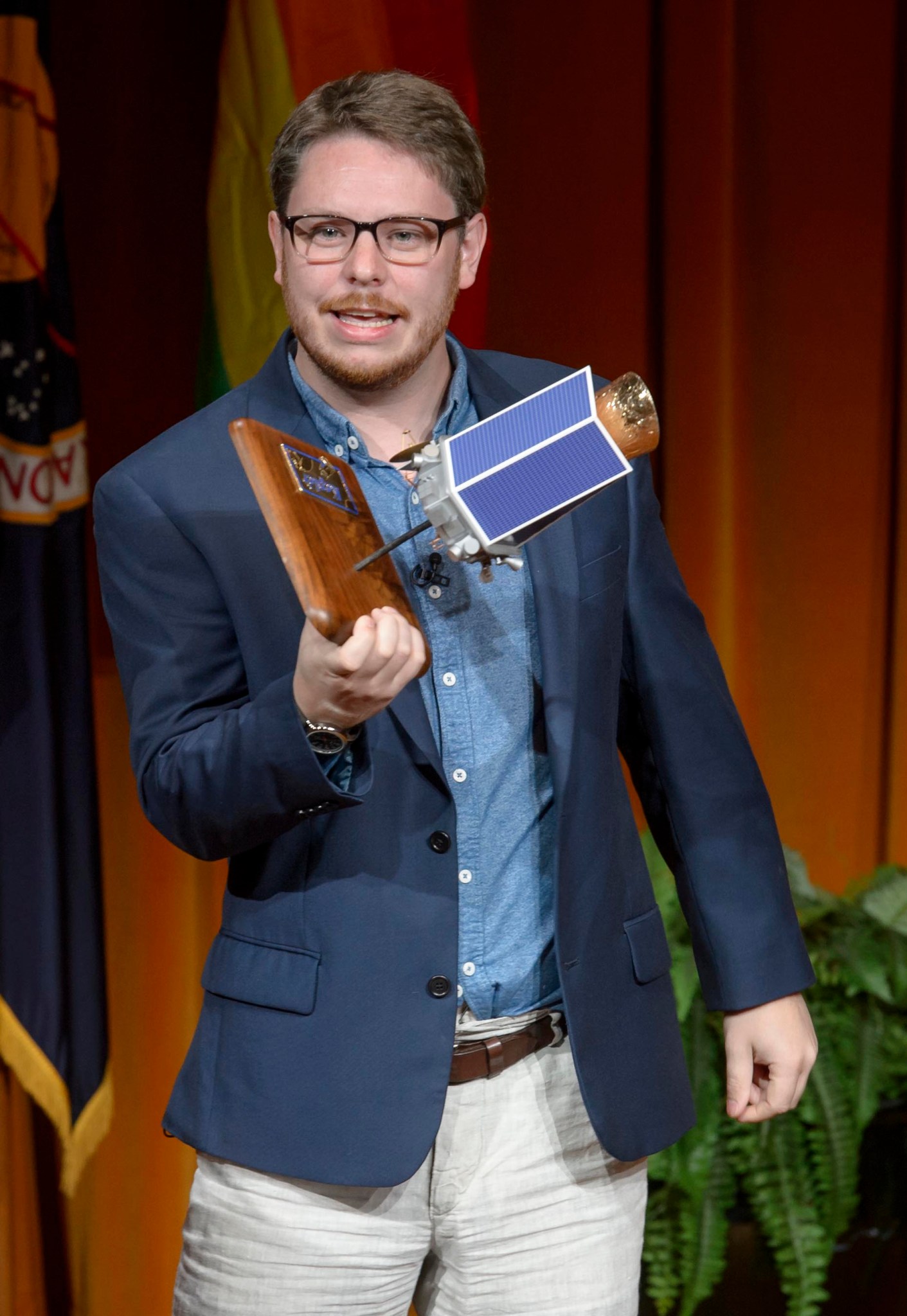
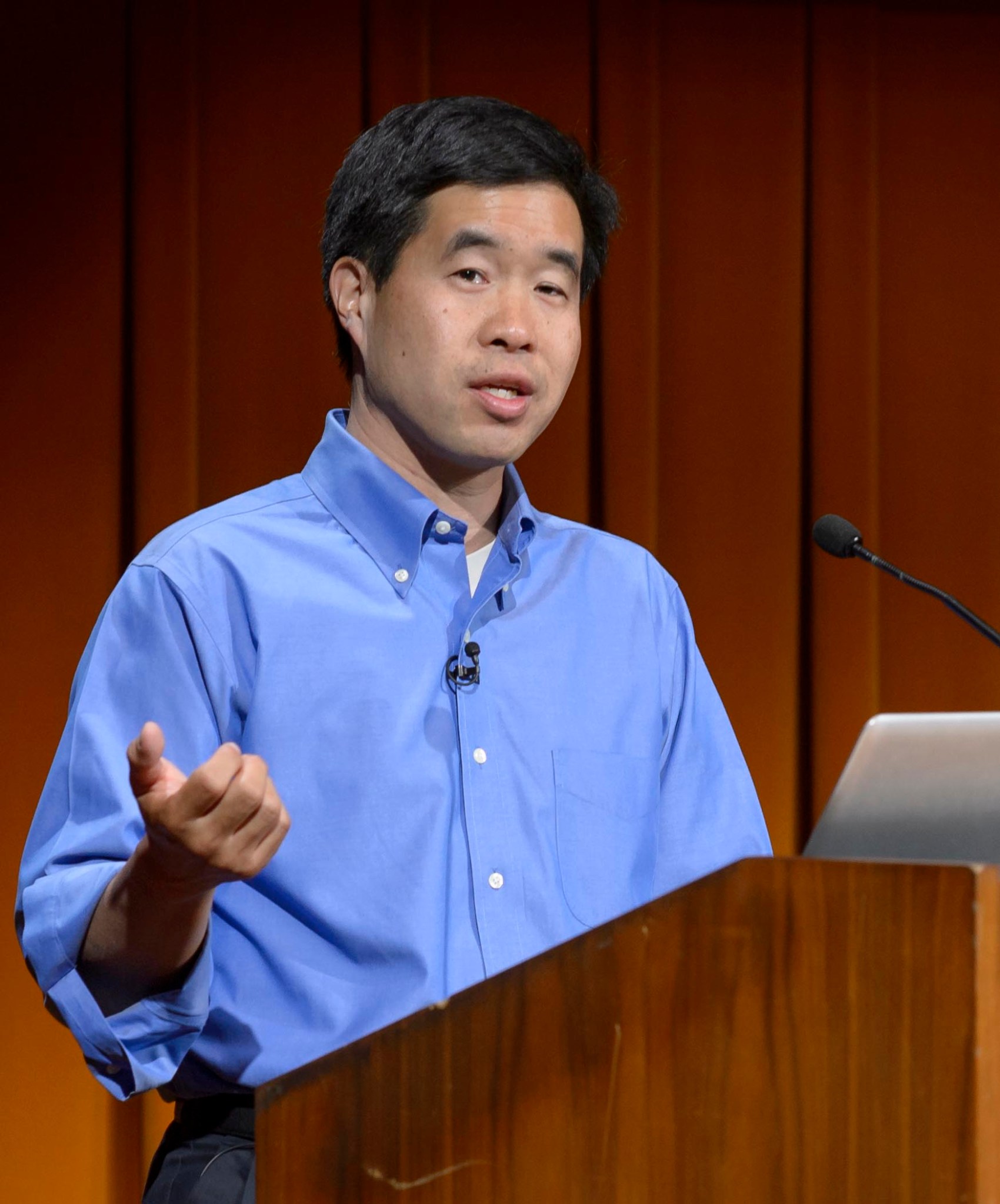
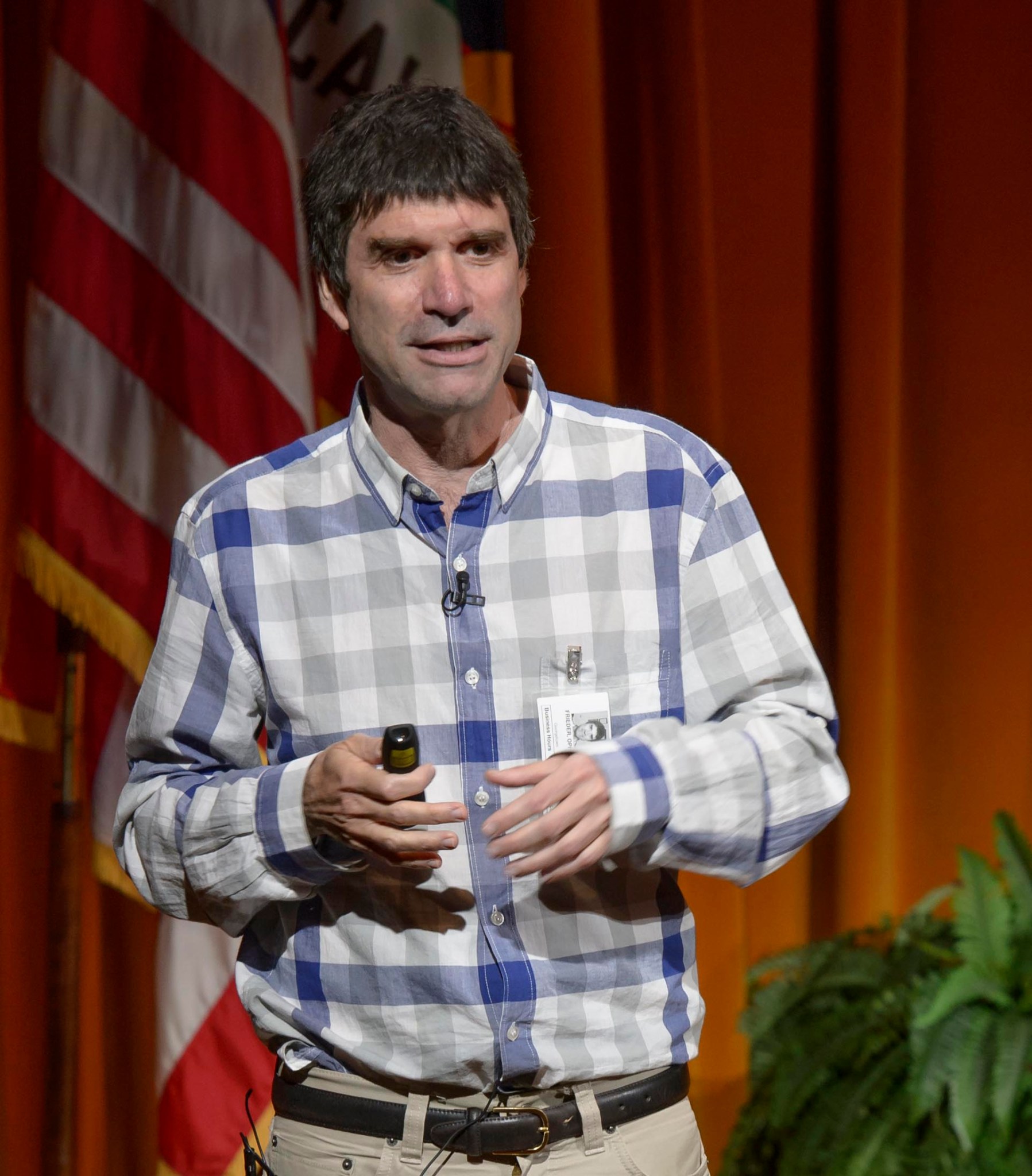
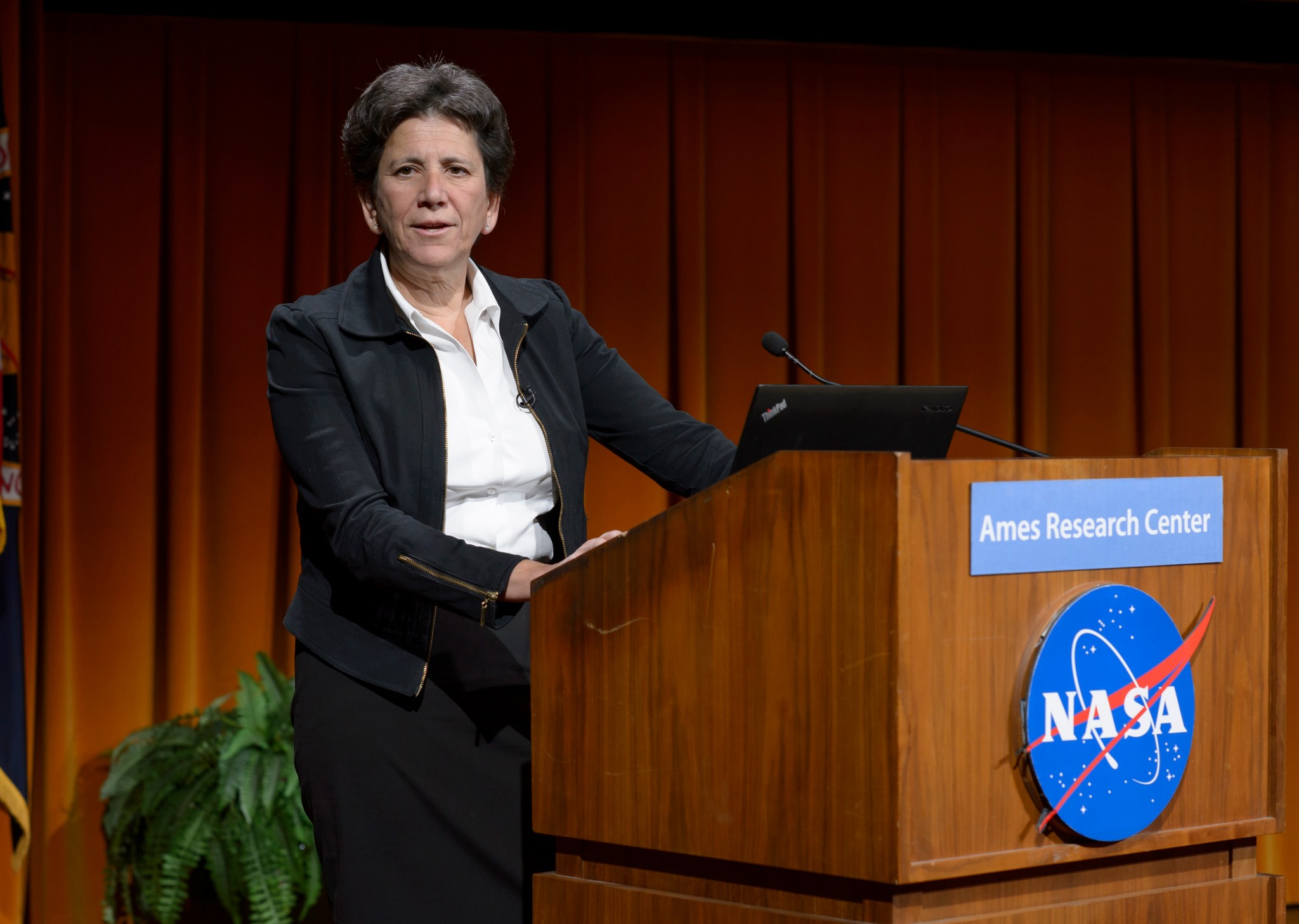
was presented by Barbara Block, on July 21, 2016, at the center. The Earth’s oceans cover the majority of the surface area of our planet, yet our understanding of the marine ecosystem is limited. Block presented her work studying tunas, bill fishes and sharks utilization of the ocean. Block holds the Charles and Elizabeth Prothro Professorship at Stanford University. Her research is focused on how large pelagic fish utilize the open ocean. She and her team have pioneered the successful development and deployment of electronic tags on tunas, bill fishes and sharks that enable following these highly migratory fish in the oceans. Block is co-founder with the Monterey Bay Aquarium of the Tuna Research and Conservation Center the only facility in North America holding tunas for research.
In Memoriam . . .
Doug O’Handley, Indomitable Influence for Hundreds of Space Professionals, Passes
Douglas Alexander O’Handley, Ph.D., died peacefully at home in Morgan Hill, California July 28, 2016, at the age of 79.
Doug is survived by his wife Christine (O’Neil) who he married on July 20, 1991, brother Donald and sister-in-law Norma, brother-in-law Jerry McCarty, stepsons and their wives Jeffrey and Megan Stube and Kevin Stube and Jessica Culler, granddaughters Lauren and Rachel Stube (children of Jeffrey and Megan) and numerous nieces, nephews, and alumni students of the NASA Ames Astrobiology Academy and NASA Space Exploration Academy. Doug is preceded in death by his parents Malcom (Syd) and Georgie, sister Gayle McCarty, and son Douglas Alexander Jr.
Doug was born on May 7, 1937, in Detroit, Michigan. He graduated from the University of Detroit Jesuit High School and the University of Michigan, and worked at the U.S. Naval Observatory in Washington, D.C. while receiving his doctorate in Astronomy-Celestial Mechanics at Yale University in 1967.
Doug’s career began at the Naval Observatory accompanying atomic clocks to remote islands in the Pacific and Australia before joining NASA JPL where he managed a robotics group focusing on robotic vision and navigation, then NASA Headquarters in biomedical engineering in the Office of Industry Affairs and Technology Transfer. He returned to the JPL Biomedical Application Office through 1984, when he transitioned to Ames for a period including time on the Life Sciences Senior Management Council. He was detailed to TRW in Southern California before returning to NASA Headquarters as Deputy Associate Administrator for Exploration. From 1988-1992 he was a member of the committee that created the Space Exploration Initiative – a nationwide planning initiative to take NASA into Extended Duration Exploration Missions, back to the moon and on to Mars. Doug created the Exploration Advisory Committee and worked with the White House’s National Space Council. In 1992, Doug returned to California and Ames where he developed the Center for Mars Exploration.
In the mid-1990s, Doug created and taught a multi-disciplinary undergraduate course in astrobiology at Santa Clara University. He – and the course – were wildly popular. From this course and the program initiated by Jerry Soffen at NASA Goddard, the seeds were planted for the NASA Ames Astrobiology Academy – a summer leadership development program committed to excellence that has operated for nearly 20 years (later the Space Exploration Academy).
The Academy catalyzed and inspired the lives of more than 240 students, many of whom are now well-established in scientific disciplines and careers around the country, ranging from NASA flight surgeons and principal investigators on multiple missions, to leaders inspiring others with their careers in academia, government and industry. Doug and Christy drew enormous pleasure from hosting the students that each year brought to their home on evenings, weekends and holidays – whether skiing with astronauts at Squaw Valley, boating on Lake Tahoe or backyard BBQs. The Academy students quickly became a part of Doug’s family, always welcome at any time. Doug was present for many life events of his former students, including officiating three weddings and introducing more than a dozen couples who are now married.
Doug was a member of the International Astronautical Academy, Fellow of the American Astronautical Society, Fellow of the Royal Society of Medicine in England, Associate Fellow of the Aerospace Medical Association, and a member of the U.S. Senior Executive Service.
Doug was both a competent scientist and a faithful Roman Catholic, passionate on the subject of faith and reason. He was a good friend of the former Vatican astronomer, George V. Coyne, who he met when they were both teaching at Georgetown University. Doug was very active at St. Bede the Venerable Catholic Church in La Cañada, California, for which he brought a relic of St. Bede from England which is now mounted in the main alter of the sanctuary. He was also an Extraordinary Minister at St. Catherine’s Catholic Church in Morgan Hill.
Doug loved to travel with his wife Christy all over the world – from as close as Monterey, California, and their second home in Tahoe City, California, to across all seven continents.
A memorial service will be held on a date to be determined. In lieu of flowers, please donate to one of the following, in memory of Dr. Douglas A. O’Handley: University of Michigan, The Elbel Club; Yale University Graduate School; cancer research organization of your choice.
Orbis Flying Eye Hospital Stops Over at Ames
Orbis is a leading international, non-profit organization that has been a pioneer in the prevention and treatment of blindness for more than 30 years. Orbis operates the world’s only Flying Eye Hospital, a fully equipped mobile teaching hospital, on board an MD-10 aircraft. It appears as if it’s a regular aircraft on the outside, but inside, it is an ophthalmic hospital and teaching facility. Orbis transforms lives by delivering the skills, resources and knowledge needed to deliver accessible quality eye care. Working in collaboration with local partners including hospitals, universities, government agencies and ministries of health, Orbis provides hands-on ophthalmology training, strengthens healthcare infrastructure and advocates for the prioritization of eye health on public agendas. Their motto is that when you can see, it’s easy to take your vision for granted. But giving vision to someone who doesn’t have it is life-changing and reverberates through families, communities and, ultimately, economies. In July 2016, it landed at NASA Ames/Moffett Field for a Stanford Hospital tour of the aircraft.
A Foreword from the Director of Military Programs at NASA Ames
by Lt. Cmdr. Leedjia Svec, Ph.D.
Summertime is often filled with BBQs, lounging by the pool and enjoying the long warm days ahead. At NASA Ames, it is always filled with interns embarking on a new journey. Whether they study government or astrophysics, Ames hosts interns in a win-win exchange. Mentors receive significant work and support while students learn more about their fields and mature their skills.
Part of the mission of the military programs office is to support STEM and diversity. In addition to their work this summer, several students volunteered to assist in outreach and STEM events. These activities included showcasing African-American STEM professionals, coding in a hackathon for the Navy, honoring pride and serving on a Wonder Women in Tech panel. These students went above and beyond to immerse themselves in the Silicon Valley culture while contributing to NASA.
The following articles are their accounts. I believe these articles demonstrate that experiences both within and outside the internship help them grow while positively representing NASA to both the local and wider community. As the summer comes to end, I am energized for the future and looking forward to the wonderful contributions that each student and mentor will continue to make this summer and in our expanding universe.
“Coming to NASA made me excited, working on the leading edge made me proud. To me, nothing beats the thought of looking at technology in the future, technology that will do good for the world, and knowing that you helped make it happen,” stated NASA intern Nicholas Weidow.
Hack-the-Sky – NASA Interns Get Up Close and Personal with Drones
by Lucia Simova and Su Wei Heng
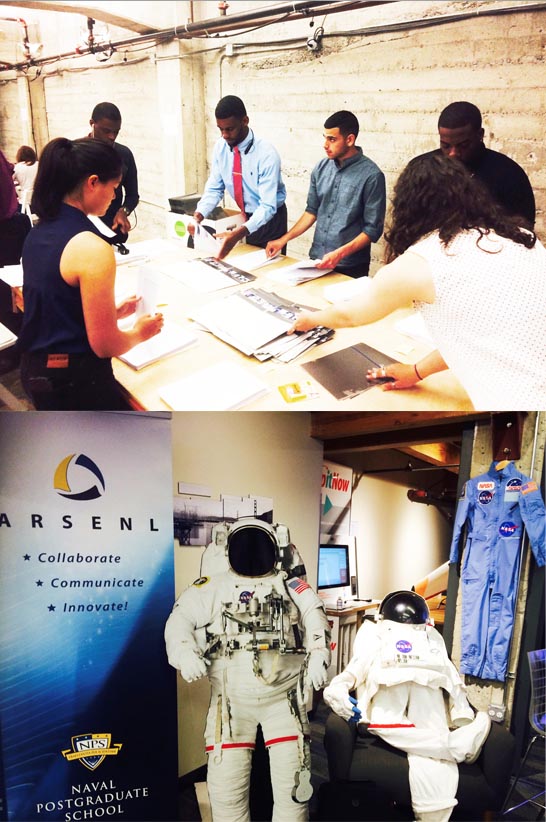
Ever wonder what it’s like to get up close and personal with an Unmanned Aircraft Vehicle (UAV), or drone for short? That’s what a group of NASA interns and other participants got to do June 24 – 26, 2016. The event was called Hack-the-Sky and unlike a traditional hack-a-thon, this one focused on making UAVs impervious to attacks (cyber and otherwise), gathering an effective swarm and creating innovations that would help the Navy within the next 10 years.
Participants, who were either hackers or designers, had a chance to pitch and then implement their ideas to be ultimately showcased to a group of judges who would then choose which ones could be implemented within the Navy. The attendees ranged from local high school students and college interns, to subject matter experts (SMEs) in their particular fields, to Navy personnel including the Under Secretary of the Navy, Janine A. Davidson.
On Friday night, June 24, participants were invited to share their preliminary ideas and network with various attendees in the Autonomy of the Future Workshop, where design-thinking exercises were introduced. Participants also heard from various experts in the fields on the three challenges that were presented throughout the hack-at-thon. On Saturday, June 25, the official hack-a-thon kicked off as ideas were presented in 30-second intervals and designs were beginning to take shape. Participants in the design-thinking workshop presented their solutions to the Undersecretary of the Navy, creativity was encouraged and several groups utilized a skit format to convey the problem and solution. Thankfully, all team members were valued for their input no matter how small, and everyone was able to let their imaginations roam as they explored the future of Navy swarm operations.
On Sunday, June 26, the hack-a-thon continued with final presentations and awards given out by the Undersecretary. In the end, the gathering was a success for the host of the event, Defense Innovation Unit Experimental (DIUX), with participation by the Naval Post Graduate School, NASA and others. The results help these agencies stay at the forefront of innovation where Naval officers and civilians had a chance to garner their input and work collaboratively. As interns, it was empowering to be included and valued for our contributions in coding at the hack-a-thon and assisting with the event.
Celebrating Juneteenth
by Lucia Simova and Su Wei Heng
On June 19, 1865, two-and-a-half years after the Emancipation Proclamation, Union soldiers led by Major General Gordon Granger arrived in Galveston, Texas, with the news that the Civil War had come to an end and that all slaves were now free. This historic date is now commemorated by cities across the nation in a festival known as Juneteenth. San Francisco held its 66th annual Juneteenth festival on Saturday, June 18, 2016, in an event filled with food, live music stages and tents containing different organizations dedicated to outreach and education regarding their respective causes/missions.
One row of tents, for example, was devoted to African culture, including food and dress. NASA’s booth was nestled with a handful of other tech companies and was represented by summer interns and their supervisor. On display was a presentation made by intern Jessica Feinberg, handouts from the Office of Education and Public Outreach and plenty of NASA stickers. The volunteers took turns wearing a spacesuit, which effectively drew in the masses to their tent. Adult- and child-sized spacesuit cut outs helped attract passers-by who were interested in photographs.
Upwards of a thousand people stopped by for a NASA sticker, and the majority of those exchanges led to conversations in which the volunteers answered questions about NASA Ames’ current mission and increased awareness about NASA research programs. More importantly, the interns and Lt. Cmdr. Svec spent the day encouraging parents to cultivate their children’s interest in STEM fields, and successfully increased the visibility and representation of African-American people in STEM, historically and presently.
Hundreds of attendees came to the NASA tent unaware that there were any African-American astronauts and left with newfound knowledge. Ultimately, the team believes that some of the younger audiences, particularly the Mars generation, walked away inspired and with dreams of donning their own spacesuits one day.
Wonder Women in Technology
by Lucia Simova, Alejandra Ruiz and Su Wei Heng
On the weekend of July 16 – 17, 2016, a group of NASA interns participated and spoke on a panel at the Wonder Women Tech conference at the Long Beach Convention Center in Long Beach, California. Wonder Women Tech is a non-profit organization which produces an annual conference and series of educational programming and initiatives that highlights, educates and celebrates women and diversity in Science, Technology, Engineering, Arts and Mathematics (STEAM) innovation and entrepreneurialism. Activities are geared toward empowering women and diverse demographics.
This year’s conference included workshops, a career fair and multiple platforms for women and men to provide their insights on how they are increasing and celebrating diversity in STEAM fields. The theme of the conference this year was #WeArePioneers with representatives from the President’s advisory council, the United Nations, Google, Virgin Galactic and of course, NASA.
The NASA panel theme was #WeAreAllAstronauts. One NASA panel allowed audience members to have a question-and-answer-session with astronaut Nicole Stott, while a later panel facilitated a discussion of internships at NASA Ames and the capability for everyone to be involved in space. The panels were very well received with attendees saying it was inspiring, encouraging and the highlight of the conference.
The experience left many participants, and certainly all us interns, believing we are indeed Wonder Women in Tech, regardless of our majors. It is hoped that NASA will continue to participate in and support the Wonder Women Tech conference as well as other conferences aimed at increasing representation and diversity.
NASA Navy Intern Exchange Shows Similarities Between Both Entities
by Jonathan Kaldani and Jessica Feinberg
On July 11, 2016, several NASA interns were hosted by Navy interns at the Naval Post-Graduate School (NPS) in Monterey, California. It was an amazing experience during which we met fantastic interns passionate about their projects at NPS, ranging from cyber security to Russian linguistics, sleep deprivation to app development and more. Not only does NPS have a beautiful campus, they have amazing laboratories with the latest technology where students are working on various projects such as swarm unmanned aerial vehicles that could revolutionize the way the United States uses drone technology. For us, it was informative and inspiring to see the similarities that the Navy and NASA share, and how we can mutually support each other’s projects in the aim of increasing the total capabilities of the U.S. government.
One week later, we hosted the NPS interns in return, showcasing NASA technology and presenting our own work. NASA interns highlighted their work on infrastructure prognostics, fatigue, Arc Jets, diversity, database creation and programming and flight design. We took them on a tour of NASA facilities, from the Hyperwall and supercomputer to the Vertical Motion Simulator, from the Arc Jets facility to the Fluid Mechanics Lab, and from the centrifuge to Hangar 1. At the end of the day, we hosted the interns for an informal meal as they did when we went to NPS, and cemented the relationships we hope will help NASA and Navy develop closer collaborations in the future.
Taking Pride in STEM
by Jessica Feinberg
Science has always concerned itself with discovering the truths of the universe – of its material composition, the laws that bound its physical behavior, the behavior of the creatures that roam throughout it. In his book The Age of Wonder, a biography of the Romantic period of scientific exploration, author Richard Holmes says, “Physical vision – one might say scientific vision – brings about a metaphysical shift in the observer’s view of reality as a whole. The geography of the earth, or the structure of the solar system, are in an instant utterly changed, and forever.”
Michael Faraday’s discovery of electromagnetic induction allowed the development of electrical generators, which underpin so much of our society’s functioning today. Louis Pasteur’s development of the germ theory of fermentation led to his creation of pasteurization, allowing people to drink milk with a reduced fear of bacterial infection. Alexander Fleming’s discovery of penicillin was groundbreaking in the medical field, and Isaac Newton’s development of a law of universal gravitation changed physics forever. Discovering one truth about the universe has a ripple effect, paving the way for deeper investigations and more thorough theoretical frameworks.
The same can be said for diversity and representation. In the words of author Junot Díaz, “If you want to make a human being into a monster, deny them, at the cultural level, any reflection of themselves.” For this reason, the scientific community has an ethical and practical imperative to broadcast the diversity of its practitioners and researchers, as science as a whole will suffer if whole portions of the world cannot see themselves in STEM.
According to McKinsey & Co.’s Diversity Matters report (2014), companies in the top 25 percent for racial diversity are 35 percent more likely to exceed national industry medians; they are 15 percent more likely to exceed the same medians when they are in the top quartile for gender diversity. Additionally, according to Dr. Jodie Rummer, “If we have more diversity in science, we also have more diverse approaches and therefore a greater ability to solve [problems],” and increased diversity among researchers can prevent the oversights that occur when a field is overwhelmingly homogeneous. For example, there has been significant literature produced on the negative medical affects on women that come from a male-centric practice, including misdiagnosis of heart disease, because women present symptoms differently, and improper dosage recommendations, because dosage guidelines are often based on clinical trials on average-size men (National Geographic, 2014).
For the LGBT+ community, representation in the scientific community remains crucial, particularly at a time when 49 people can be slaughtered because of their identities while in a space designed specifically for them. With this community in particular, a major problem is not just the diversity of scientists but their representation, as LGBT+ status is not something that can be easily gleaned from a photograph or a name.
There are many historical figures in science whose orientations are rarely, if ever, mentioned: Sir Francis Bacon, the father of empiricism; Alan Hart, who pioneered the use of x-ray photography in tuberculosis detection; Florence Nightingale, founder of modern nursing; Alexander von Humboldt, pioneer in biogeography; Alan Turing, (though the recent biopic The Imitation Game addressed his orientation); Sofia Kovalevsky, mathematician and developer of Kovalevsky’s Theorem; Louise Pearce, pathologist, who studied syphilis, rabbit pox and African sleeping sickness; Sara Josephine Baker, physician who organized the first governmental child hygiene department; Margaret Mead & Ruth Benedict, anthropologists; and Leonardo da Vinci, inventor, painter, geologist, botanist, cartographer, engineer, architect and mathematician.
At NASA, there have been others: Neil Devine, astrophysicist who contributed to the modern theory of star formation; James Pollack, astrophysicist specializing in atmospheric science; and, of course, Sally Ride, first American woman in space. There are countless other scientists, both past and present, whose membership in the LGBT+ community will remain consigned to secrecy, as their orientations and/or gender identities are not common or public knowledge – whether because they have been lost in time, hidden because of their intensely private nature, or undisclosed to avoid outing someone else.
There are as many reasons to choose not to disclose one’s orientation, or gender identity, as there are LGBT+ people. For that reason, it is vital that leading scientific organizations such as NASA encourage representation of LGBT+ people in their literature and initiatives. Growing up LGBT+ can be an intensely isolating experience, and, as Sally Ride said, “You can’t be what you can’t see.” If more people can see themselves reflected in the scientific community, science as a whole will be bettered by it.
A Statistical Summary of Activities of the Protective Service Division’s Security/Law Enforcement and Fire Protection Services Units for the Three-month Period Ending June 2016 is Shown Below:
Click here to view:
Ames Ongoing Clubs/Monthly Events
NASA Ames Exchange Information
Information about products, services and opportunities provided to the employee and contractor community by the Ames Exchange Council. Visit our web site at: http://exchange.arc.nasa.gov
Beyond Galileo Gift Shop N-235 in the cafeteria, 8:00 a.m. – 2:00 p.m., ext. 4-6873
Visitor Center Gift Shop (Exploration Center), Tues-Fri, 10:00 a.m. – 4:00 p.m., Sat. – Sun, noon – 4:00 p.m., ext. 4-5412
Remember to purchase your baby shower, birthday and holiday gifts at Ames’ two gift shops!
Mega Bites Cafeteria N-235, Manager Jason Hamed, ext. 4-5969, Mon – Fri, 6:00 a.m. – 2:00 p.m., ext. 4-5969/Catering contact Karen Mcintyre, 650 444-2241
The SpaceBar: Subs & Burgers, Bldg. 3, Hours are: Mon – Fri, from 11:00 a.m. – 7:00 p.m. See: http://exchange.arc.nasa.gov/cafe/menu.html for menu items.
NASA Lodge (Bldg. 19) (650) 603-7100
Where to stay when you’re too tired to drive home? What about the lodge?! Current Rates: Bldg. 19 (43 rooms), rate: $65/night ($5 each additional adult); Bldg. 583 A&B (150 rooms), rate: $55/night ($5 each additional adult); B547 rate $60/night (for large groups)
Ames Swim Center (N-109) (650) 603-8025
The swimming pool is now open. Hours of operation are as follows (lap swim only): Mon – Fri, 10:00 a.m. – 1:00 p.m. and M-F 3:00 p.m. – 6:00 p.m. The pool is heated year round. POC: Ryan Storms, pool manager (650) 603-8025. Memberships: Yearly access $350, 3 Month $100, Single day use $5
Exchange Basketball Gym, Building 2, POC: Manager Bryan Henshaw, (650) 603-9717, Hours of operation: Mon – Fri, 11:00 a.m. – 1:30 p.m. and M-F 4:00 p.m. – 7:00 p.m. The basketball gym is a full NBA regulation size court and is free to use.
RV lots available. Call to reserve a space at (650) 604-0698. Civil Servants and Active Military $50/month. Contractors and Retired Personnel $100/month
Chase Park reservations, call ext. 4-4948
NACA Park reservations, call ext. 4-4948
Ames Emergency Announcements
To hear the centerwide status recording, call (650) 604-9999 for information announcements and emergency instructions for Ames employees. You also may listen to 1700 KHz AM radio for the same information.
Ames Cat Network
The Ames Cat Network needs help finding homes for cats trapped at Moffett. They range from feral to abandoned/lost pets. They are tested, altered and inoculated. Call Iris at ext. 4-5824 if you or someone you know are interested in fostering or adopting a cat.
National Aeronautics and Space Administration
Ames Research Center
Moffett Field, CA 94035-1000
The Ames Astrogram is an official publication of Ames Research Center, National Aeronautics and Space Administration.
Managing Editor………………….Matthew Buffington
Editor, Layout and Design……………Astrid Albaugh
Employees can reach the Astrogram Office via email at: astrogram@mail.arc.nasa.gov or by phone at ext. 4-3347.






























